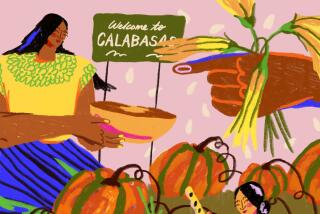The Very Scary Story of the Vanishing Pumpkins : Halloween: Midwest drought reduced the harvest, which means supplies could run out in some areas.
- Share via
WASHINGTON — This may be the Halloween of the Not-So-Great Pumpkin.
Heat, drought and early frost have put a damper on the supply and size of potential jack-o’-lanterns nationwide, especially in the Midwest. Supplies in some areas could run out well before Oct. 31, and pumpkins will cost more because of the short supply and the higher cost of growing them.
George Perry knows. The 76-year-old grower from Manteca, Calif., has his finger on the pumpkin pulse of the country. He’s been getting calls from as far away as New York and Florida asking if he can share some of his bounty.
“A lot of pumpkins are ruined back there,” said Perry, whose family operation shipped more than 15,000 tons last year and has committed almost all this year’s crop to supermarket chains inside the state.
Irrigation protected his crop and that of five farms that supply his company. Not everyone was spared in California, though. The seasonal pumpkin stands seem to be having the most problems.
“We’re getting a lot of calls even here in California for pumpkins from people who never did buy from us,” said Perry.
”. . . Evidently, where they were getting them, they can’t get them this year. They’re short.”
The heavy demand means Perry is able to charge eight or nine cents a pound rather than the six cents he received last year.
Illinois and other Midwestern states were hit especially hard.
Darin Eastburn, plant pathologist at the University of Illinois Cooperative Extension Service in Urbana, reports that the crop will only be 20% of normal in areas of the state. He found one eight-acre field with only two salvageable pumpkins.
Pumpkins just don’t like it hot.
Rather than spread pumpkin pollen, bees took a long break from the heat, and heat-stressed flowers didn’t want to open, Eastburn explained. The result was fewer pumpkins, or small ones that were easily devoured by fungi.
A killing frost Sept. 23 did in a lot of the late-setting fruit, he added.
There’s one bit of comfort, he noted. The canning pumpkins used for Thanksgiving pies are a different species and weren’t hit as hard.
In other big pumpkin states such as Pennsylvania and New York, the large growers who invested in irrigation made it through the summer, averting an out-and-out shortage. Still, pumpkins are generally smaller and more expensive, because of the lower yields and higher production costs.
“I know from some of the things I’ve seen on the national level that they are evidently in short supply across the country,” said Bill Troxell, executive secretary of the Pennsylvania Vegetable Growers Assn. “We certainly aren’t going to have any extras to make up the difference.”
For pumpkin shoppers, the best advice may be to buy early.
“We’ve gotten about all the pumpkins we think we’re going to get,” said Barry Scher, chief spokesman for Giant Food Inc., a Landover, Md., based supermarket chain with stores in Washington, D.C., Delaware, Maryland, New Jersey and Virginia.
Scher said the supplies should last through the third week of October.
“We definitely have not gotten in as many as we have had in prior years, and it’s due to the weather, the lack of rain,” he said. The pumpkins, he said, are running about 10 cents a pound higher than last year.
Perry, the old pumpkin hand, says the cost should matter little.
“If you think about it, it isn’t going to be that much more,” he said. “A pumpkin weighs 10 pounds. It’s not like a car. The stores are going to absorb a lot of that, too. . . . The little kid, he wants a pumpkin.”
More to Read
Sign up for Essential California
The most important California stories and recommendations in your inbox every morning.
You may occasionally receive promotional content from the Los Angeles Times.














